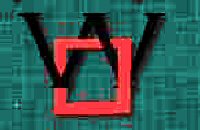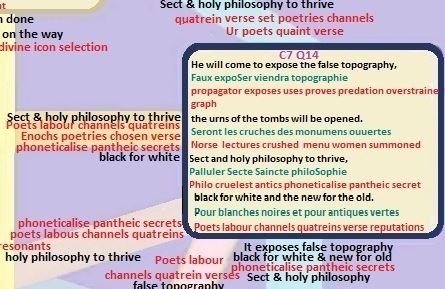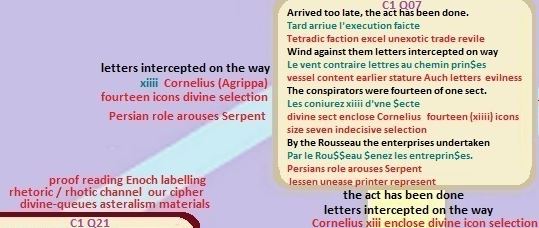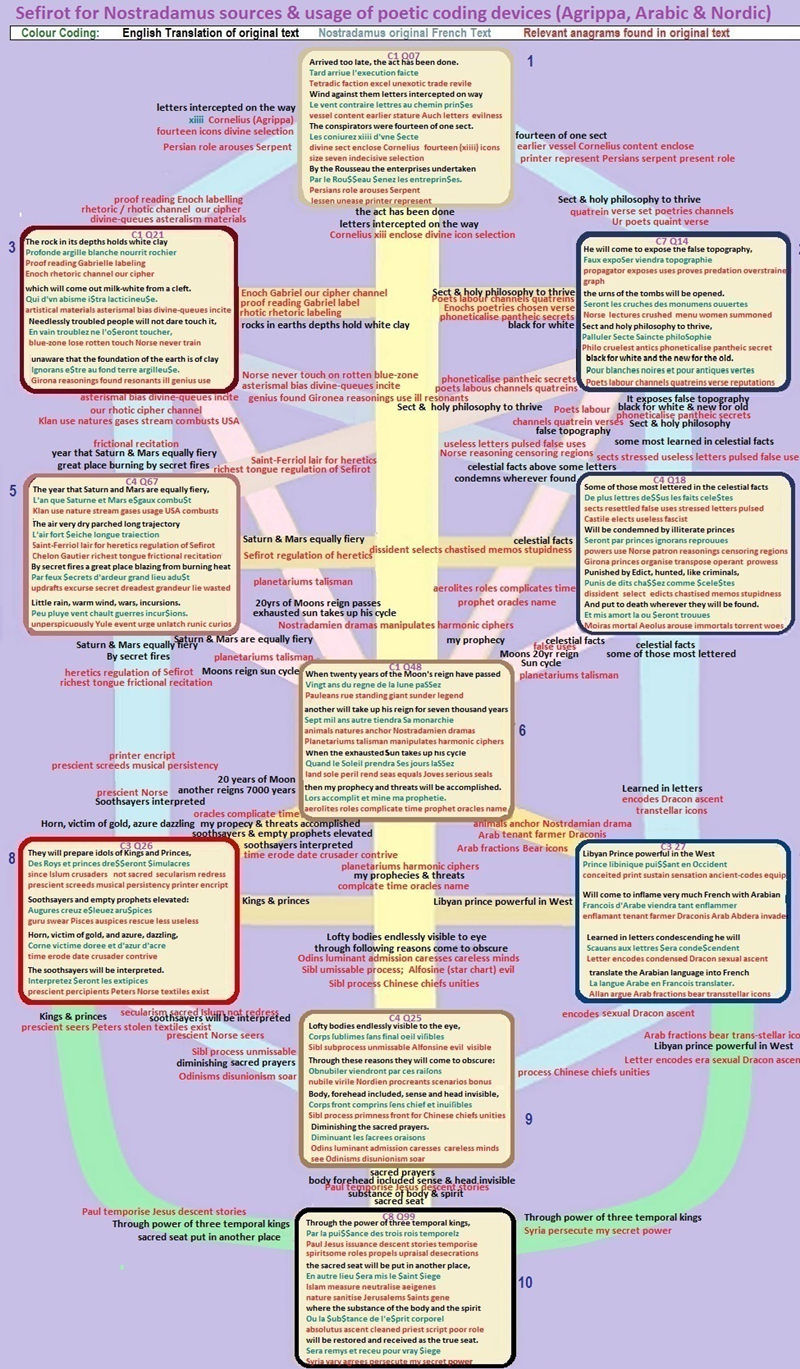 Analyses of all verses
Analyses of all verses
|
 Web Site
Web Site |
 All
Sephirots All
Sephirots |
Secrets to Nostradamus' Code: Agrippan Cipher Sephirot revealed
© Allan Webber October 2017.
 The
sixteenth century was a time in which innovative coded messaging was of great
interest to the literate communities of Europe. This high level of activity arose out
of the repression of the inquisition, military intrigue, the discovery of
knowledge that needed protection from other eyes, or a new discipline
believed to give greater insights into the until then secret workings of the
universe. For several millennia these mechanisms had played important roles. Out
of the ancient foresights came the Cabala, the secret teachings of the Templars
and the Music of the Spheres.
The
sixteenth century was a time in which innovative coded messaging was of great
interest to the literate communities of Europe. This high level of activity arose out
of the repression of the inquisition, military intrigue, the discovery of
knowledge that needed protection from other eyes, or a new discipline
believed to give greater insights into the until then secret workings of the
universe. For several millennia these mechanisms had played important roles. Out
of the ancient foresights came the Cabala, the secret teachings of the Templars
and the Music of the Spheres.
Nostradamus had many of the above reasons for including coded material into his work so when he came to do so it was inevitable he would draw on knowledge of his age. He was steeped in it from the time of his birth. His parents were Christians but like so many others of their time their recent roots were in Judaism; this was was an age of repression of Jews and mandatory conversion. But Nostradamus also spent his early adulthood in the presence of literary forces such as Jules of Agen where he read, discussed and heard about the most modern and ancient of ideals. He was exposed to heretics and ideologues and knew the penalties that came by being branded as part of one group or another.
This is because kingdoms, sects, and regions will change to the diametric opposite of that seen in the present day. If I had drawn up events as they will happen the people of that realm, sect, religion and faith, would find it so bad that they would listen to fantasies and come to damn that which future centuries will know through seeing and perceiving. Nostradamus' 1555 Preface for Cesar [PCE2]
But the danger of the times, O Most Serene King, requires that such secrets are of events that should not be manifested except in enigmatic sentences having, however, only one direction and a unique meaning, and nothing shall be put [into it] that is ambiguous nor anything of ambiguous calculation. Nostradamus' 1558 Epistle to Henry [HEE6]
Nostradamus' interest in code was however very precise; what he wanted was a means to use poetry as a way of concealing dates, coding methods, decoding instructions and prophecies. This Sephirot unites several of these aspects as it presents the mechanisms chosen to include dates. Nostradamus opted to use astronomic settings as a precise way of delivering dates independent of human calendar limitations. The planets and the stars are his clock which meant he needed to find ways to embed these settings in what people have always seen without it being obvious. The beauty of astronomic settings is they bring with them a powerful disguise since the same stellar objects are quoted by astrologers as well as astronomers. So the language of astrologers offered one mode of hiding dates.
I have made long calculation and during the time of night's sweet odours I have composed books of prophecies each containing a hundred quatrains of astronomic prophecies, which I have intentionally arranged a little obscurely. They contain perpetual predictions for (the period) from now until the year 3797. Nostradamus' 1555 Preface for Cesar [PCE6]
Later Sephirots will detail many of the methods Nostradamus used to imbed astronomic settings in his verse but what is important here is to relate it to the knowledge bases that provided strongest cover for his purpose. Hence it requires a sixteenth century reference source that can serve as a textbook of magic or grimoire for the concepts he employed. But for later generations such a scheme would be unbreakable unless there is hidden in an early part of his prophecies an identifier of his source. And more than that it needs to be an indexed reference telling later generations which part of that source carries the fundamental mechanisms on which Nostradamus relies.
With the above in mind it is the purpose of this paper to present the Sephirot Chart identifying Agrippa's work as the source on which Nostradamus relied for transforming date settings into allusions and hidden content in poetry consisting of four lines. This topic is covered in further detail in my paper called Cornelius Agrippa.
Two samples of the material included in Agrippa's work that are referenced in this Sephirot are shown below with the first giving an indication of how poetic or musical sound can be used to represent planets:
Agrippa BK II Pt III Chapt xxvi: But understanding now, that of the seven Planets, Saturn, Mars, and the Moon have more of the voice than of the Harmony. Saturn hath sad, hoarse, heavy, and slow words, and sounds, as it were pressed to the Center; but Mars, rough, sharp, threatning [threatening] great and wrathful words: the Moon observeth a mean betwixt these two; but Jupiter, Sol, Venus and Mercury, do possess Harmonies; yet Jupiter hath grave, constant, fixed, sweet, merry, and pleasant Consorts; Sol venerable, settled, pure and sweet, with a certain grace; but Venus lascivious, luxurious, delicate, voluptuous, dissolute and fluent: Mercury hath Harmonies more remiss, and various, merry and pleasant, with a certain boldness: but the Tone of particulars, and proportionated Consorts obeyeth the nine Muses. Jupiter hath the grace of the octave, and also the quinte, viz. the Diapason with the Diapente: Sol obtains the melody of the octave voice, viz. Diapason; in like manner by fifteen Tones, a Disdiapason; Venus keepeth the grace of the quinte or Diapente. Mercury hath diatessaron; viz. the grace of the quarte:
The second sample shows the table that is indicated as a source by verse C1 Q07 line 3. It gives a chart of equivalence for replacing stars and planets with names from other genres such as animals, body parts and plants.

There are over forty Sephirots that will be presented in this volume of mine and each is powerful for its contribution to the whole.
The first two pages in the current series (Sephirot code & Agrippa) contain a total of twenty different verses. They offer two clusters of anagrams which have low occurrence in the 942 verses of Nostradamus' Prophecies. Many of the anagrams in this set identify features of his coding which in itself adds to the orderliness able to be found within Nostradamus’ work.
|
Frequency of this Sephirot's most prominent anagrams in Nostradamus' Prophecies: Appearing in this cluster are words, such as
Cornelius (4), divine (5), selection (4), chosen
(7), xiiii (1), cipher (3), channel(1), channels (1),
poets (12), verse (34), poetries (3), quatreins (4),
reputation (2), chosen poetries (1), labelling (1),
labour (7), phoneticalise (1), rhetoric (1), rhotic (1),
asterismal (2), asterism (10), propagator (1), richest
(10), tongue (10), Sephirot (12), regulation (6).
These are clearly rare and English
variants of terms highly related to Nostradamus and his
coding methodology. |
Even with this small group of two Sephirots traits stand out that will be seen throughout those that follow.
One such attribute is that of unity where anagrams of small number appear disproportionately in topic relevant clusters. For example in the two presented so far several rare anagrams are found in both Sephirots despite there being only a few in all the verses.
This repetitive aspect is a primary way in which they enhance the value of their aggregation since repetition, complexity and rarity make the clusters, Sephirots and anagrams even more difficult to ignore.
Another aspect involves anagrams in each Sephirot of this book that complement those found in others. They aren’t repetitions of terms but repetitions of themes, ideas, names and events. They do this by the number of adjacent anagrams that link to both text and the cluster of anagrams in Sephirots. And these factors can be illustrated through the contributions of verse C7 Q14 which is part of the current Sephirot.
The first line of text indicates it could relate to disclosure of all Nostradamus' code but it also implies revelation of the meaning of this verse. Alongside is a table of the frequencies of the topic relevant anagrams in the cluster of ten verses used in the Sephirot that follows. A large number of the terms in the table can be found in this single verse.

For instance rearranging the spacing in the last line in one way we which gives a sequence channels poetries our quaint verse poets (get lanchesn oiresetp our antique). Re-arranging the order of this sequence we get Poets verse channels our quaint poetries.
Alternately the line’s lettering can be arranged as
chosen verse poets reputation rise (chesno
ires etpouranti .. esver tesPo).
That there is one poignant sequence
is remarkable enough but two is inexplicable given both have internal logic and
consistency and make relevant contributions to understanding Nostradamus’ code.
It is easy to see these two remarkable sequences as answers to the questions posed by the first line of text but it also gives meaning to the fourth line where they are found.
That line states black for white and the new for the old
and that is what is now true in that there is now a means to read the verses by
changing the white spaces separating the black lettering.
There is of course
much more in the cluster of ten verses than can be obtained from one. To gain
insight into what these versec contribute to each Sephirot I have included a
synopsis in the right hand column.
A powerful clue is the use of xiiii for fourteen in the text of C1 Q07 rather than the conventional xiv. It is a hidden cipher since it incorporates the number format Heinrich Cornelius Agrippa used in his books on codes and symbolism. Chapter xiiii in his book II discusses planets and ciphers for the number twelve. This clue is supported by an anagram for Cornelius also found in C1 Q07. In the same line as xiiii and the Cornelius anagrams appear there are also adjacent anagrams for select divine (or heavenly) and icon selections. And a divine selection is what is portrayed in Agrippa's table labeled Chapter xiiii.

All the above and more can be seen in the Sephirot for Agrippa where I have tried to highlight the many connections between the verses in ways useful to the reader. And in discussing this chart I have left in material that shows not all anagrams uncovered are relevant. The factors that make them less important are related to the likelihood of them being there by chance. Rarity, sequencing and unity with content in the text are the primary drivers with links between the anagrams also being a determinant of relevance.
But equally important is the degree to which they are formed from structures independent of the text. So finding words that are changed into a complex anagram by the addition of an s or any other single letter increases the likelihood it is formed by chance alone. Hence the importance of an anagram's complexity and rarity can be re-rated by the triviality of its construction.
Below is the Sephirot tree which reveals Nostradamus' coding sources. In this chart I have tried to highlight the many connections between the verses in ways useful to the reader.
For access to analyses of the verses in this table go to H C Agrippa or Quatrain Verses.
To see all Sephirots on my siteAccess to the individual verses and the original paper where these analyses first appeared can be gained via the links below:
| C1 Q07 | C7 Q14 | C1 Q21 | C4 Q18 | C4 Q67 | C1 Q48 | C3 Q27 | C3 Q26 | C4 Q25 | C8 Q99 |

End of Paper